Fund Management, Currency Exchange
Fund Management
What fund structure is supported in Alma?
Alma provides a flexible, hierarchical fund structure that the library can customize to meet its needs. The fund hierarchy:
- Ledger
- Summary
- Allocated
A ledger must be defined, but not all the levels need to be utilized (e.g. it is possible to define a ledger, and an allocated fund, but not have a summary fund.) An institution may create many ledgers. A ledger generally contains one or more summary funds, and allocated funds under each summary fund. The allocated accounts contain actual monetary balances used to pay for library resources. There is no limit to the number of funds that can be created, and no limits to the number of funds that can be used for payments.
An example of a ledger record with its associated funds:
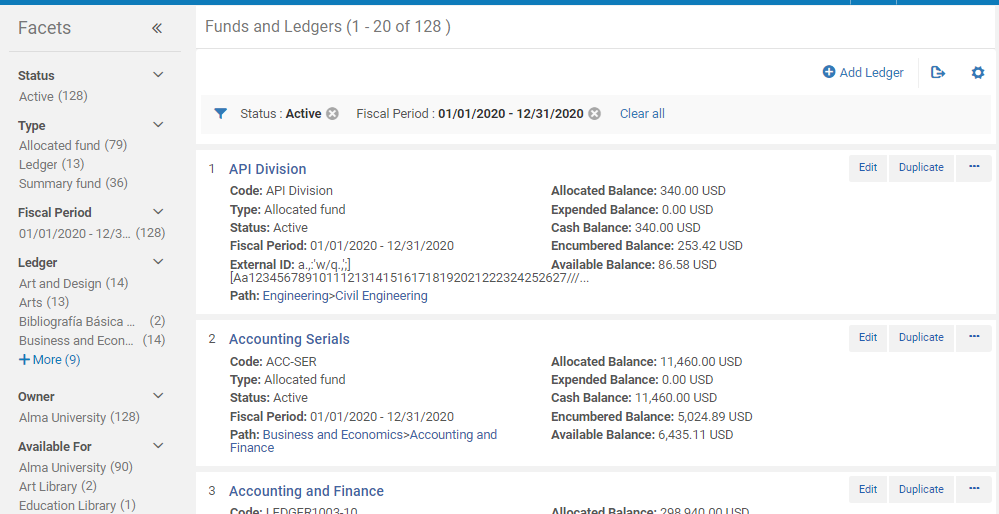
Fund expenditures is a designated subject area in Alma Analytics. The transactions are the measurable facts, and all the other attributes are dimensions. This allows for the easy measurement of expenditure by vendor, fund, purchase type, date ranges, classification, etc., and any combination of these. Most dimensions are composed of multiple levels, for example Date->Quarter->Fiscal period, or Collection->Location->Library, so drill downs on the reports are possible without any additional work.
Alma’s fiscal period close operations provide a variety of options that allow each library to create a new financial structure (e.g. roll over funds and ledgers) and roll over current orders in accordance with the library’s financial and reporting requirements. It is also possible to define a FPC percentage factor for the increasing or decreasing of a new allocated fund or PO Line.
Does Alma support real-time access to fund balances?
Alma supports real-time fund balances, including a graphical display of the fund balance showing encumbrances and expenditures. Additionally, each fund displays a history of transactions (including positive and negative transactions) and the balance in the fund at the point of each transaction. The following screen capture shows transaction details of a fund:
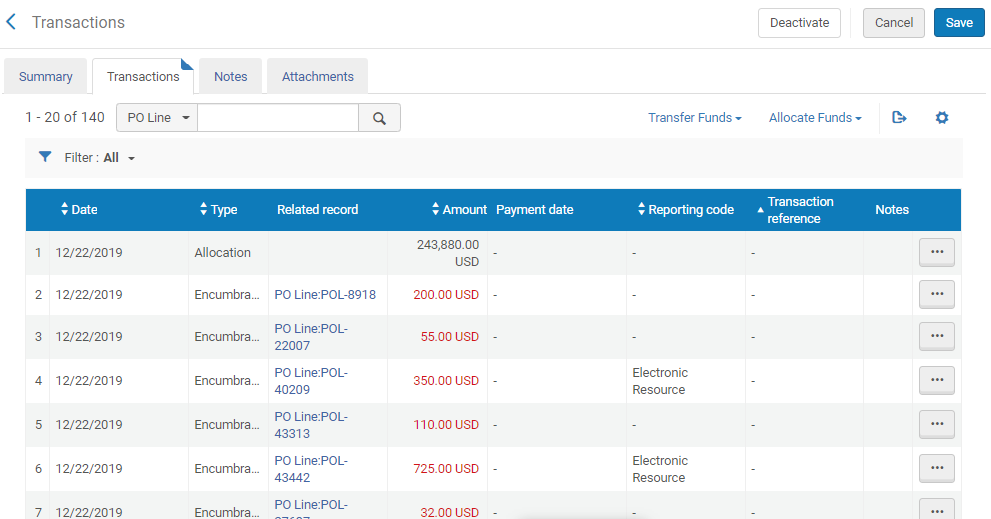
Can the staff user link from a fund to orders and invoices associated with the fund?
Links to related records (PO lines and Invoice lines) are listed in the transactions tab of the fund record. An example of this can be seen in the following screen capture:

Via analytics, it is possible to create reports regarding purchase orders/invoices associated with a specific fund for a specified period of time.
How are encumbrances and payments recorded?
All fund transactions are recorded on the transactions tab of the fund. As part of the online display of fund information, Alma also provides a graphical display of fund balances, based on the real-time balance of the account at any given moment.

Users can also see a graphic display of the fund burn down – generated from a standard report in Alma Analytics:

What rules can be defined for funds related to over encumbrance, expenditure etc.?
Rules may be associated with each level of the fund tree that defines when the system will warn or block transactions—e.g., whether over-expenditures are allowed or the grace period for encumbrances before a fiscal period close. These rules may be inherited or overridden by funds lower in the hierarchy.

Can money be transferred from one fund to another?
Money can be transferred from one fund to another. The transaction can be viewed in the Fund transaction list (as a debit or credit line). New funds can be created and funds can be deactivated at any time. The following screen capture illustrates the option of transferring money from one fund to another:
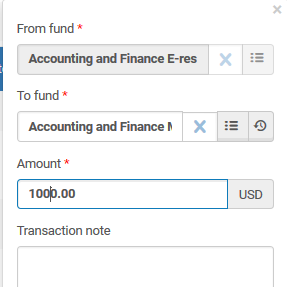
How does Alma handle fiscal rollover?
Alma’s fiscal period close operations provide a variety of options that allow each library to create a new financial structure and roll over current orders in accordance with the library’s financial and reporting requirements.
As part of the fiscal period close, the Purchasing/Ledger manager runs a system job that copies the ledger of the current fiscal period with all the summary details and allocated funds to the new fiscal period, if required. Changes to the ledger or allocations can be made during the process. If the next fiscal period does not exist, Alma creates a new one. Fiscal periods are defined by each Alma institution; Alma can accommodate any yearly definition of a fiscal period. An institution may have one or multiple ledgers, depending on local financial requirements.
At the end of the current fiscal period, the Purchasing/Ledger Manager rolls over the current open orders to the new fiscal period, and can specify if the encumbrances should be increased or decreased automatically by a specified percentage. The new year’s encumbrances can be based on the previous fiscal period’s encumbrances, or optionally on the previous fiscal period’s expenditures, which allows the library to base the encumbered amounts on the actual payments in the prior year. Once the orders have been rolled over to the new period, the previous fiscal year is closed and the new fiscal year becomes active.
Step One: Ledger Rollover
This is the first step in the fiscal period closure process. As part of the fiscal period closure, the Ledger Manager runs a job that copies the ledger of the current fiscal period with all the summary details and allocated funds to the new fiscal period, if required. No changes to the ledger or allocations are made during this process. If the next fiscal period does not exist, Alma creates a new one.
Ledgers and funds can be created as either “active” or “draft”. Draft ledgers are useful when creating the new fund structure in advance; ledgers are made active when the institution is ready to begin using the fund structure.
Create Allocation when adding a ledger rollover job allows for moving the remaining balance from the current fiscal period to the next fiscal period when creating the new funds.
- Allocation Balance – The allocated funds are copied with their allocations to the new ledger for the new fiscal period.
- None – No allocations are created for the new fiscal period.
- Cash Balance – The calculation of the new allocated balance moves only the remaining balance for the new fiscal period.
- Both – The calculation of the new allocated balance is changed to include the remaining balance for the new fiscal period.
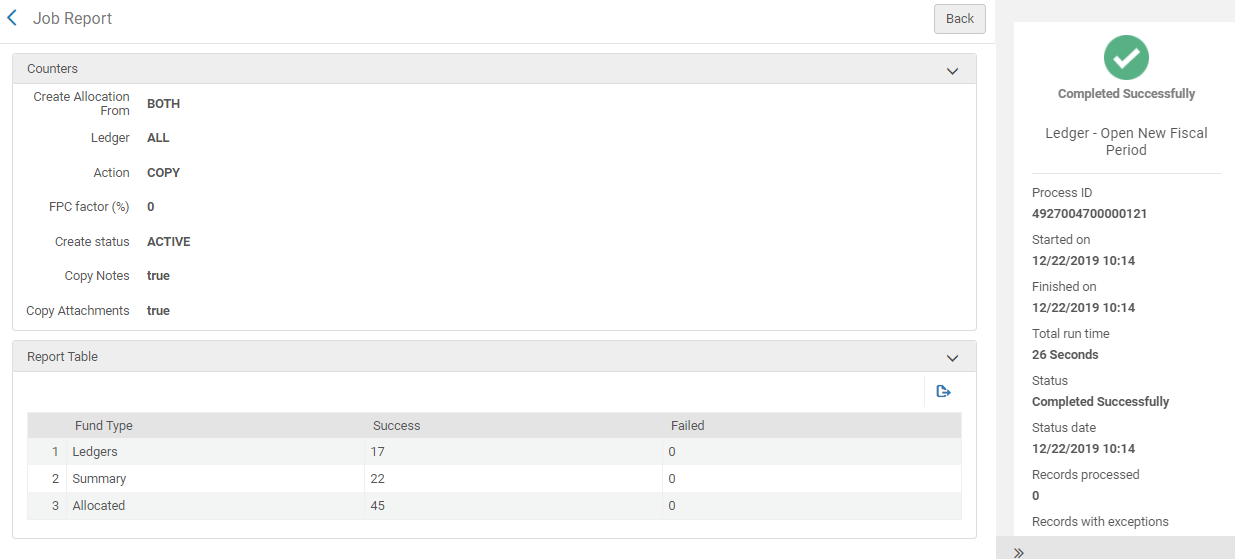
Step Two: Rolling Over PO Lines
A job must be run to copy the encumbered PO lines to the new fiscal period. During the rollover process, you can select whether you want to increase or decrease the amount of the encumbered PO line. Please note that before performing a PO line rollover, you must first perform a ledger rollover.
PO line rollover is performed on all active, continuous PO lines and on active, one-time PO lines that still have an encumbrance.
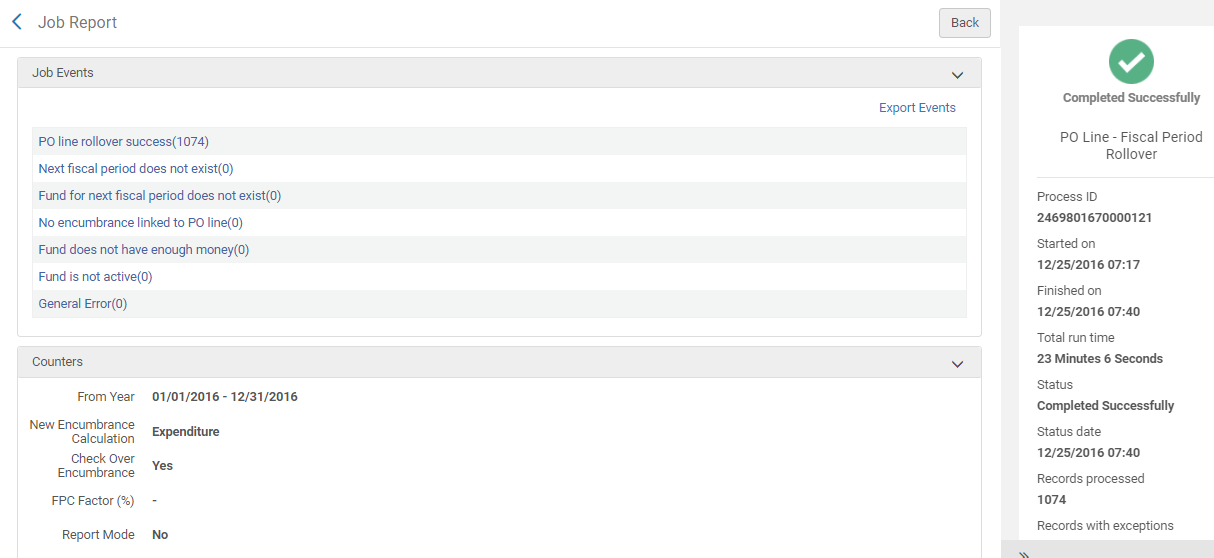
if a PO Line cannot be rolled over the report will complete with an Error status. Details of the PO Lines that failed can be viewed in the report output:
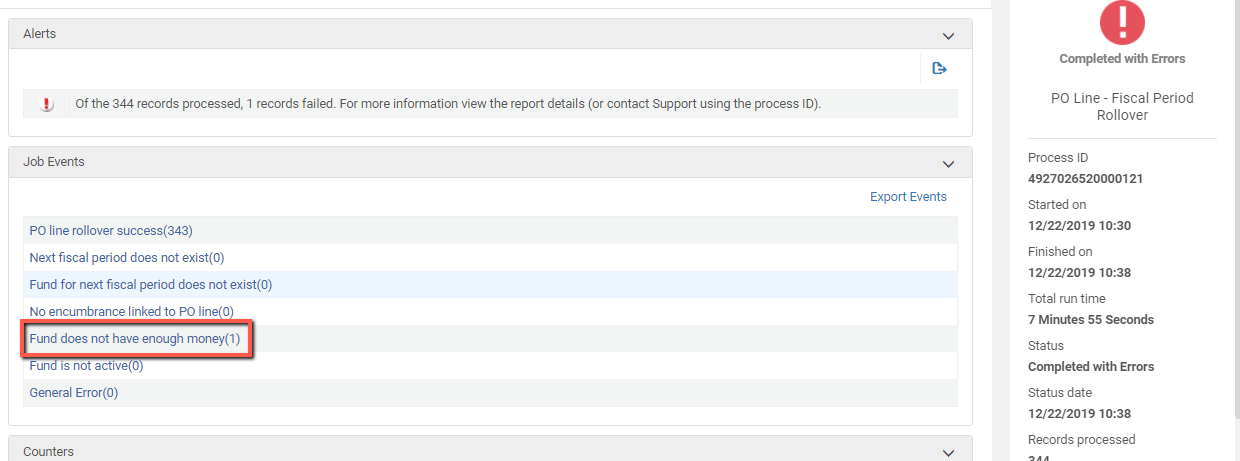
Are there any limits regarding the number of funds or limits to the length of fund codes?
There is no limit to the number of funds which can be created. Most codes in the system are limited to ten characters, while the descriptions of the codes are practically not limited. Regarding the fund code, there is a 255 character limitation.
Currency Exchange
How does Alma manage currency exchange rates?
Ex Libris partners with Open Exchange Rates (https://openexchangerates.org) for exchange rate currencies.
For the current list of supported currencies, see https://openexchangerates.org/currencies.
For the current list of supported currencies, see https://openexchangerates.org/currencies.
Alma holds a single universal currency repository (based on ISO currency codes) with six decimal places, which includes current and historical rates. The repository is updated on a continuous basis. To help libraries track and manage currency changes, Alma also provides an exchange rate report, which can be run in real-time to generate a list of recent exchange rates.
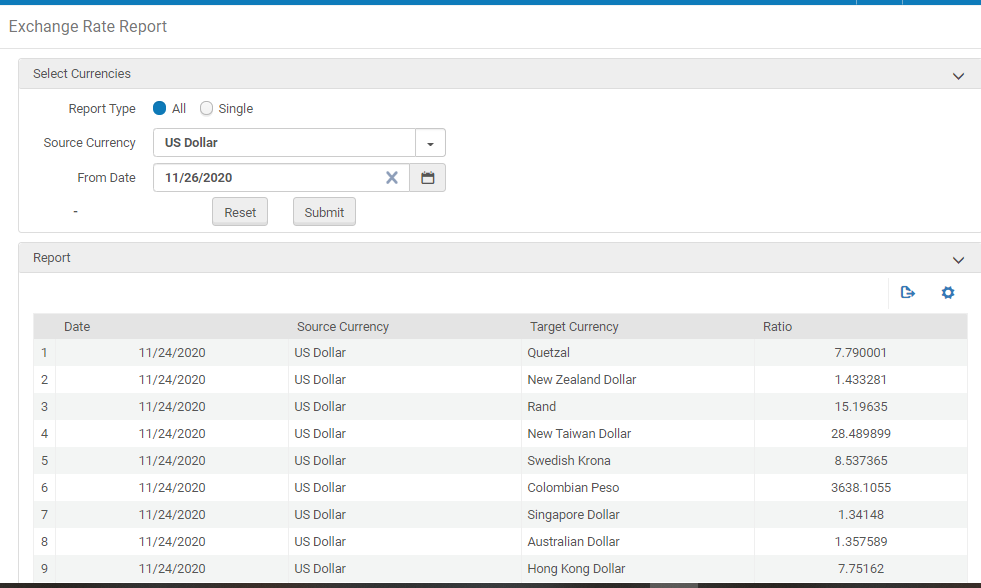
As part of configuration options available in Alma, the library may choose a currency subset from a list of worldwide currencies loaded and maintained by Alma. Only the currency values defined in this subset will display in the relevant parts of the Acquisition workflows:
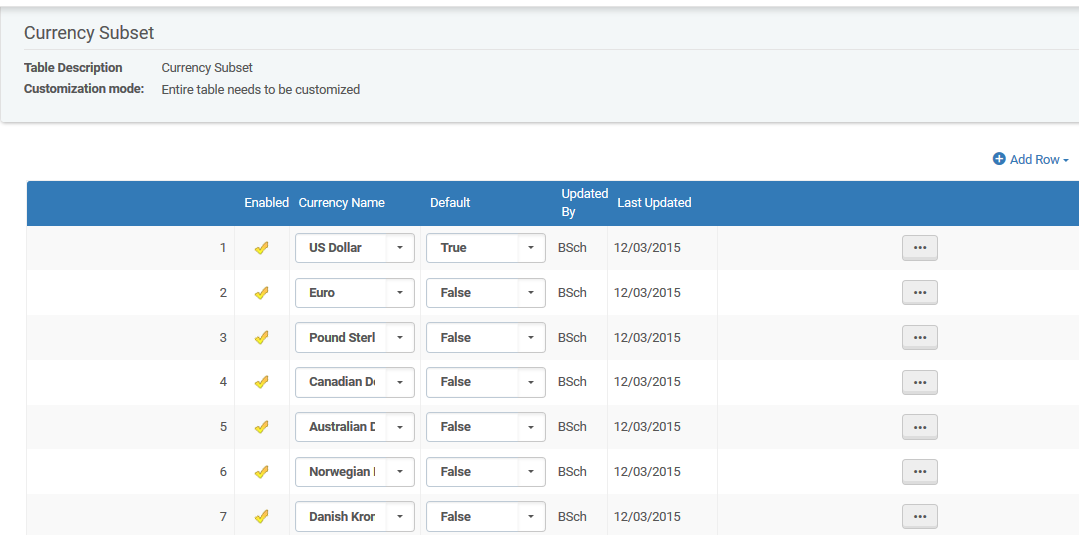
A vendor record may support one or more currencies:
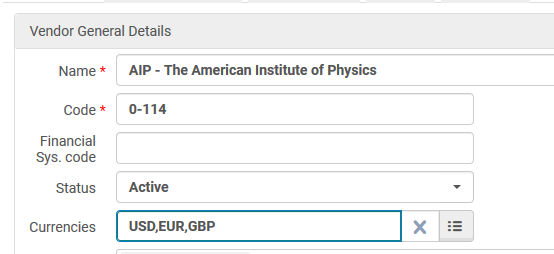
Transactions will always display in the default currency, but staff can view the exchange rate details (from the view button on the transaction line of the fund):

Total views:
3796
